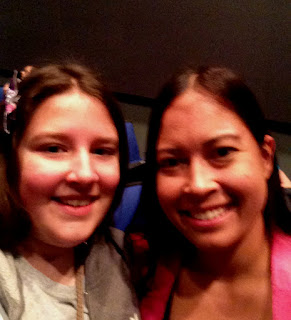SPREADING HER WINGS: This morning, we pointed the Honda southbound at 7:30, a bit earlier than usual. However, our destination made it worth navigating through rush hour traffic: The Museum of Flight. Annabelle had a special workshop to attend. I'll let her tell you a bit about it.
Today I had the honor of going to an event at the Museum of Flight called “Women Fly”. Because I had a reservation, I could go early and watch a presentation from Jessica Cox, the first registered armless pilot. She was born without arms and had to learn all the other things other children in her school were learning on her own, because the teacher didn’t know how she would teach an armless student how to do things like tie their shoes. But Jessica eventually learned to make her laces very loose and then tie them with her toes. She couldn’t put them on and then tie them because that would mean her toes couldn’t be used. She told us to “think outside the shoe” and remember that nothing is impossible.
She also answered some questions, like if she’s ever had trouble doing things due to an injury. She said yes, one time she sprained her ankle and hyper-extended her knee, leading to her being in a wheelchair for about a month. She got through it with determination, and now she’s done many amazing things without arms, from being a black belt in Tae Kwon Do to being a surfer to being a pilot.
I also went to a few small workshops. The first was about Cassini, a satellite which has been able to orbit Saturn for 12 years. It’s been able to study Saturn this long because instead of using fuel on the trip to Saturn, it used other planets as slingshots to propel Cassini further without using nearly as much fuel. We had a board on the table with magnets in the middle representing Titan, Saturn’s largest moon. My friend and I used metal balls and rolled them towards titan to slingshot towards Saturn’s other moons. It was actually much harder than we imagined, but it was fun nonetheless.
The second workshop I went to was about lightning and static electricity. My group used combs to make static electricity from our hair and pick up small paper bits like confetti.
There were also generators that we had fun “shocking” toy planes with. The event was fun and if you can get reservations next year, you really should!
ADDED BONUS: We weren't quite sure what time Annabelle's workshop would be over, so right after CJ got out of a class at noon, we headed back south to The Museum of Flight to hang out and wait for Annabelle to be done.
I asked CJ what he wanted to see there and he said something he's never seen or done at the museum before. That led to him taking a spin in a flight simulator.
Below, he's doing a little 'pre -flight' training.
He reports the experience was fun, and a little nauseating.
After the 'flight,' I asked him where he wanted to go. He said the World War I and II wing, so there we headed. On the way in to that part of the museum, I noticed a sign.
I looked at my phone, saw it was 1:03 and told CJ to hustle, so we could check out the presentation. I had no idea what we were in for. I'm *so* glad we went!
I'll have CJ tell you a little bit more about it. ...
Today, my sister spent the morning at the Museum of Flight, a frequent haunt for my family, located down South in Tukwila. She was going for the Women Fly event, which is The Museum of Flight's annual event for youth interested in aviation, aerospace, and STEM futures.
Meanwhile, my mom and I were visiting other parts of the museum. We were visiting the World War branch of the museum, which contains several planes and other relics from both World Wars I and II. On the way in, we noticed a sign, promoting a speech being given by a World War II veteran.
We went to a little "hut" structure in the back of the exhibit to hear the speech. At the hut was Jim Marich, a B-29 flight engineer. was giving a very interesting talk about an experience over and in the Pacific Ocean, that he had back during November 1944's 3rd week (11/12 to 11/18):
In 1944, when Marich was 19 years old, he was the flight engineer on a Boeing B-29 Superfortress, flying over the Pacific Ocean.PHOTO: U.S. Air Force
The B-29 was flying for a bombing (and, by the sound of it, suicide) mission, and was close to Iwo Jima, a Japanese island. If I remember correctly, Marich was one of 11 crew members on the B-29. The plane's pilot was 25 years old (much older than the rest of the crew), and thus he earned the nickname "Old Man."
At some point during the third week of November 1944, the plane encountered a 200 MPH headwind, blowing against them. Since the B-29 was only going at 230 MPH, this meant that the plane was essentially going at just 30 MPH, and consuming very large amounts of fuel.
The B-29 and its crew completed their mission (a bombing run), but knew they would not make it back to base. They made preparations for a water landing, throwing things overboard and expending all of the fuel.
The Pacific water below the plane was mostly going up in swells, primarily around 60 feet tall. The pilot of the plane actually had to try and crash land the plane on one of the swells, an especially risky and abnormal bet. It was assumed that the plane's tail would break as a result of the "landing". After landing the plane in the water using the 60-foot swell, there was a desperate rush to get outside of the plane.
The B-29's crew was told that any plane that hit the water would sink within 90 seconds. The people in the back (6 of them, if I remember correctly) had to quickly crawl through an awkward tube, just to get to the front section of the B-29. Those in the front section of the B-29 (which included Marich) had to crawl through a tiny window on the pilot's side of the plane, just to get out.
After getting out of the plane, life rafts were inflated, and the crew started eyeing which ones they were going to climb into, figuring that's where they would eventually die.
Miraculously, out of seemingly nowhere, a PT Boat appeared, and pulled up next to the plane. Instead of getting in the raft, the crew of the B-29 ended up getting in the PT boat, which included getting wet up to their knees.
Despite thinking that the plane would sink within 90 seconds, according to Marich, the plane didn't sink for more than 48 hours after "landing" on the water.
Shortly before his 20th birthday, Marich would be back at home, in his bed, and the war was over.
Overall, the speech given by Jim Marich was very interesting. Marich also mentioned that there are probably many, many B-29s in Mariana's Trench. I wonder how-well preserved and B-29s in Mariana's Trench would be.
This photo is of *the* very plane Marich was on that was ditched in the Pacific in 1944. He found it by chance, while flipping through a book about B-29s in the gift shop at The Museum of Flight.
We feel fortunate to hear Mr. Marich's story that unfolded 72 years ago.
I found a couple of interviews with Marich. I'm so glad his experiences are recorded for posterity.
And here is a video of Marich's presentation very similar to what we saw today, in that same little hut in the back of the World War wing of The Museum of Flight.


































